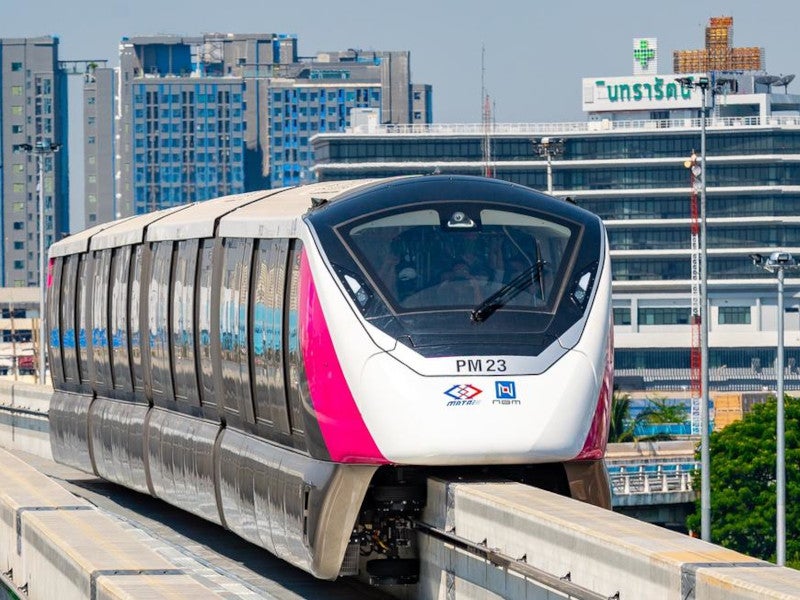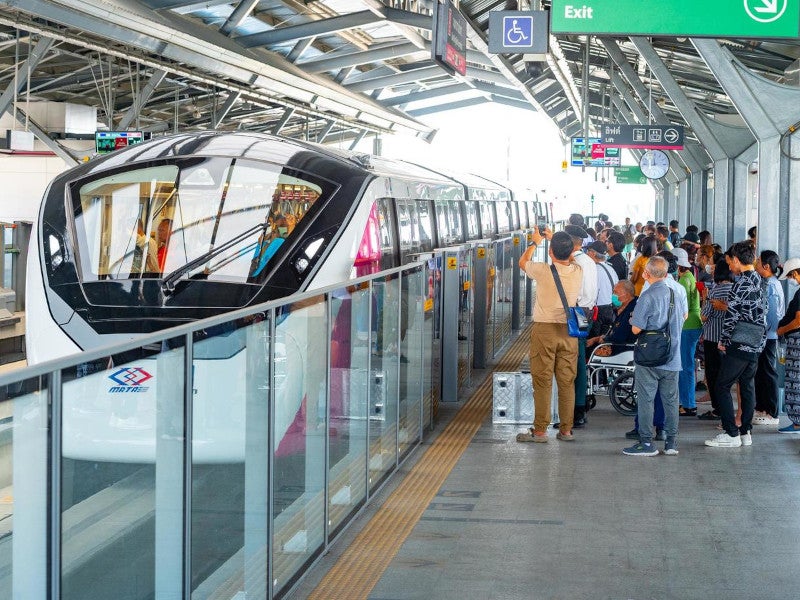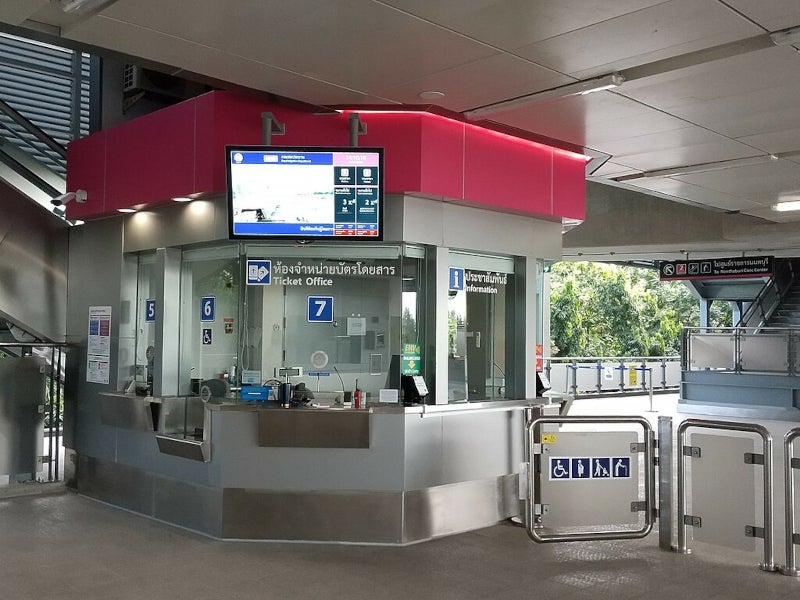The MRT Pink Line monorail project is a 34.5km mass transit system developed between Khae Rai and Min Buri in Bangkok, Thailand. It has significantly reduced travel duration by more than 50%, bringing it to less than an hour.
The Pink Line spans 30 stations between Chaeng Wattana and Ram Intra, seamlessly connecting with five other rail lines to enhance accessibility along the city’s east-west transport routes. The Pink Line will have two more stations by 2025, improving the connection between Bangkok and Nontaburi province.
The Pink Line was developed as a public-private partnership (PPP) net cost concession by the Mass Rapid Transit Authority of Thailand (MRTA), the lead agency in developing and implementing mass rapid transit (MRT) projects, at an estimated cost of Bt53.5bn ($1.6bn).
The MRTA, the State Railway of Thailand and the Bangkok Metropolitan Administration are the three government bodies involved in preparing, implementing and operating MRT projects in Thailand.
The construction contract for the Pink Line was signed in June 2017, while commercial operations began in December 2023.
Development details
The Thai government proposed the development of the Pink and Yellow lines through a PPP net cost concession contract.
In December 2016, the BSR Joint Venture (BSR), consisting of BTS Group, Sino-Thai Engineering and Construction and the Ratchaburi Electricity Generating Holding, secured the construction bid for the lines. The government was tasked with land acquisition and committed to funding civil works valued up to Bt20.13bn for the Pink Line and Bt22.35bn for the Yellow Line.
BSR, as the concessionaire, was charged with providing civil works, mechanical and electrical systems, and operations and maintenance services for both projects. The company was also tasked with managing automatic fare collection and the commercial development of the system. The projects were implemented based on granting the concessionaire the right to operate and collect revenues for 33 years and three months for each project. The timeframe includes three years and three months for construction, followed by 30 years for train operation and maintenance.
The Northern Bangkok Monorail Company, a special-purpose entity established by BSR, was appointed to operate the Pink Line following a concession agreement signed with the MRTA in June 2017.
Pink Line project details
The MRT Pink Line, the first monorail project under the Mass Rapid Transit Master Plan (M-MAP) for the Bangkok metropolitan region, operates between Min Buri district and Nonthaburi Province.
The line commences at the Nonthaburi Civic Center, near the Khae Rai intersection on Rattanathibet Road, providing an interchange with the Purple Line that runs from Bang Yai to Bang Sue.
It traverses Muang Thong Thani, the government complex dedicated to His Majesty, and the Lak Si intersection, linking to the Dark Red Line. The Wat Phra Sri Mahathat station, adjacent to the Phithak Ratthathammanun Monument, offers a connection to the Dark Green Line. Passengers from the Min Buri terminal can also access the Orange Line, which extends from Taling Chan to Min Buri.
A new park-and-ride facility with a 3,000-car capacity has been constructed at Min Buri station.
BSR has proposed a 2.6km extension of the Pink Line from Si Rat Station on Chaeng Wattana Road to enhance connectivity to the burgeoning Muang Thong Thani region. The extension will link with the existing Pink Line at Muang Thong Thani Station (PK10) and run along Chaeng Wattana – Pak Kret 39 road to the lake in the Muang Thong Thani area. It will feature two new stations, Impact Muang Thong Thani (MT01) and Lake Muang Thong Thani (MT02).
Station details of the Pink Line
The rail project includes the construction of 30 elevated stations, some of which are integrated with other mass transit lines to facilitate passenger transfers.
Public address systems, escalators, lifts, toilets and information displays are provided at the new stations.
The project also includes the construction of a 118,400m² (1.27 million ft2) depot at the Min Buri station. Passengers on the Orange Line can also use the park-and-ride facilities at the depot, as the station acts as an interchange between the two transit lines.
Construction of the Pink Line
Pre-cast concrete girders and single columns with a dual track were chosen as the viaduct structures for the Pink Line project. Steel guideway girders with a span length of 25m are also installed at some of the locations.
The elevated structures comprise single-column and portal frame substructures with a span length between 20m and 30m.
The columns have a diameter of 1.5m to 1.8m and are placed on a pile cap or barrette pile.
Track and rolling stock details
The track gauge of the Pink Line is 1,435mm. The project uses 750V DC rolling stock with three to four cars, with a service capacity of more than 30,000 passengers an hour in each direction.
The Innovia monorail trains have been chosen to operate on the line. The trains will run at speeds up to 80km/h and carry 470,000 people each day.
The line features Cityflo 650 GOA4 driverless autonomous signalling, communication systems, power supply and conductor rail, track switches, station screen doors and depot equipment.
Signalling
The signalling and communication utilised for the line will be the same as those employed by the Chaloem Ratchamongkhon Line.
Ticketing
A paid-to-paid ticketing system is implemented on the Pink Line, which allows passengers to change lines seamlessly without exiting and re-entering the system.
Contractors involved in the MRT Pink line
Kirloskar Brothers Thailand, a pumping solutions provider, collaborated closely with Sino Thai Engineering and Construction on the entire 34.5km length of the Pink Line, comprising 30 stations. During the process, Kirloskar Brothers Thailand installed 60 FM/UL Vertical Turbine and Horizontal Split Case pumps at the park-and-ride stations to ensure the safety of travellers and property.
Alstom, a rolling stock manufacturer, was awarded the contract for supplying the Innovia monorail system in 2017. Innovia monorail trainsets were manufactured at the Alstom joint-venture CRRC Puzhen Alstom Transportation Systems in China.
Egis, an engineering services provider, worked as a project consultant for the Pink Line’s PPP project.
Dextra Group supplied Bartec splicing systems for the project.
MRT Yellow Line construction details
MRTA granted the rights to the Eastern Bangkok Monorail Company, a special-purpose entity established by BSR, to construct the Yellow Line Skytrain project connecting Lat Phrao and Samrong districts in June 2017.
Construction work began in July 2018. The Yellow Line was developed with a total investment of Bt51.8bn ($1.5bn). The MRT Yellow Line commenced revenue service in July 2023.
The Yellow Line (Lat Phrao-Samrong) constitutes a straddle monorail system on an elevated structure, spanning 30.4km and encompassing 23 stations. Serving as an interconnecting line, it links the Blue Line at Ratchada station (also known as Lat Phrao station on the Blue Line) with four other mass transit lines.
The first driverless urban line in Bangkok features 30 four-car monorail train sets, along with fully automated train control and seamlessly integrated wayside railway systems. The trains run on the line at a maximum operating speed of 80km/h and can transport 200,000 passengers a day.






